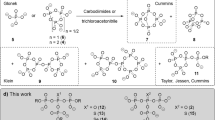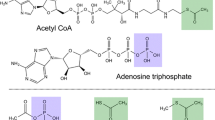Summary
When an oligonucleotide primer pG10 is incubated with the nucleotide analogue 9-[3-hydroxy-2-(hydroxymethyl)prop-1-yl] guanine diphosphate (\(p\overline{\overline G} p\), I) in the presence of poly(C), addition of the monomer occurs almost exclusively at the 5′-terminal phosphate rather than the 3′-terminalcis-glycol. The implications of this finding in the context of prebiotic condensation reactions are discussed.
Similar content being viewed by others
References
Gilham PT (1962) An addition reaction specific for uridine and guanosine nucleotides and its application to the modification of ribonuclease action. J Am Chem Soc 84: 687–688
Hill AR Jr, Nord LD, Orgel LE, Robins RK (1988) Cyclization of nucleotide analogues as an obstacle to polymerization. J Mol Evol 28: 170–171
Inoue T, Orgel LE (1982) Oligomerization of (guanosine 5′-phosphor)-2-methyl-imidazolide on poly(C). J Mol Biol 162: 201–217
Joyce GF (1987) Nonenzymatic template-directed synthesis of informational macromolecules. Cold Spring Harbor Symp Quant Biol LII: 41–51
Joyce GF, Inoue T, Orgel LE (1984) Non-enzymatic template directed synthesis of RNA random copolymers. Poly(C,U) templates. J Mol Biol 176:279–306
Joyce GF, Schwartz AW, Miller SL, Orgel LE (1987) A case for an ancestral genetic system involving simple analogues of the nucleotides templates. J Mol Evol 29: 101–107
Orgel LE (1968) Evolution of the genetic apparatus. J Mol Biol 38: 381–393
Orgel LE (1986) Mini review. RNA catalysis and the origins of life. J Theor Biol 123: 127–149
Schwartz AW, Orgel LE (1985) Template-directed synthesis of novel, nucleic acid-like structures. Science 228: 585–587
Schwartz AW, Visscher J, Bakker CG, Niessen J (1987) Nucleic acid-like structures. II. Polynucleotide analogues as possible primitive precursors of nucleic acids. Origins Life 17: 351–357
Sulston J, Lohrmann R, Orgel LE, Miles HT (1968) Nonenzymatic synthesis of oligoadenylates on a polyuridylic acid template. Proc Natl Acad Sci USA. 59: 726–733
Tohidi M, Orgel LE (1989) Some acyclic analogues of nucleotides and their template-directed reactions. J Mol Evol 28: 367–373
Visscher J, Schwartz AW (1988) Template-directed synthesis of acyclic oligonucleotide analogues. J Mol Evol 28: 3–6
White HB III (1976) Coenzymes as fossils of an earlier metabolic state. J Mol Evol 7: 101–104
Woese CR (1967) The evolution of the genetic code, chapter 7. In: The genetic code. Harper & Row, New York, pp 179–195
Author information
Authors and Affiliations
Rights and permissions
About this article
Cite this article
Rodriguez, L., Orgel, L.E. Pyrophosphate formation as the most efficient condensation reaction of activated nucleotides. J Mol Evol 32, 101–104 (1991). https://doi.org/10.1007/BF02515382
Received:
Issue Date:
DOI: https://doi.org/10.1007/BF02515382




